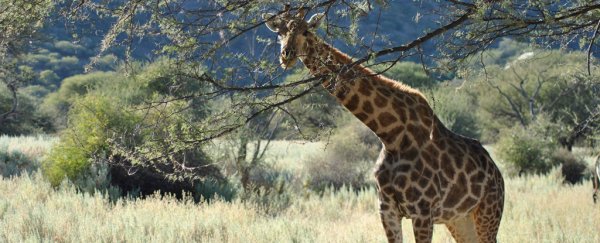The tallest animal in the world has been brought tragically low, with new research revealing that the global giraffe population has plummeted by up to 40 percent over the last 30 years.
This means the giraffe (Giraffa camelopardalis) is now officially listed as "Vulnerable" on the Red List of Threatened Species.
The Red List, which is maintained by the International Union for Conservation of Nature (IUCN), only currently recognises a single species of giraffe (G. camelopardalis), although researchers recently identified four distinct species of the animal.
While the IUCN is waiting more data before confirming that reclassification, the overall picture for giraffes looks bleak, with numbers dropping from approximately 151,702–163,452 individuals in 1985 to 97,562 in 2015.
That's a 36–40 percent decline, depending on which 1985 estimate you start with, and the resulting change in Red List status is something to be concerned about.
The animals were previously considered "Least Concern", which means an animal is at the lowest risk of extinction.
In contrast, "Vulnerable" means giraffes are at high risk of endangerment in the wild – the final classification before four categories rating extinction prospects or confirming extinction.
And the IUCN is in no doubt as to who's responsible, attributing the dramatic fall to the effects of a growing human population in the regions where the animal lives: southern and eastern Africa, with smaller populations in west and central Africa.
The IUCN says the negative impact is due to a combination of illegal hunting, habitat loss from expanding agriculture and mining, increasing human-wildlife conflict, and civil unrest.
"Whilst giraffes are commonly seen on safari, in the media and in zoos, people – including conservationists – are unaware that these majestic animals are undergoing a silent extinction," says co-chair of the IUCN SSC Giraffe and Okapi Specialist Group, Julian Fennessy.
"As one of the world's most iconic animals, it is timely that we stick our neck out for the giraffe before it is too late."
While the decline follows similar trends for other animals common to Africa – including rhinos and African lions – the IUCN acknowledges that even it was caught off-guard by the giraffe's plunge.
"While there have been great concern about elephants and rhinos, giraffes have gone under the radar but, unfortunately, their numbers have been plummeting, and this is something that we were a little shocked about, that they have declined by so much in so little time," Fennessy told Matt McGrath at the BBC.
"In these war-torn areas, in northern Kenya, Somalia, and Ethiopia in the border area with South Sudan, essentially the giraffes are war fodder, a large animal, extremely curious, that can feed a lot of people."
But while the situation is grim in terms of overall numbers, per the IUCN's current classifications of the giraffe – one species, comprised of nine subspecies – it's not all bad news.
Of the nine subspecies, five have decreasing populations, but three are actually increasing in numbers, and one is stable.
But to hold onto those small victories – and to stem the flow of the populations that are in steep decline – the IUCN is calling on all the regional governments to step up their biodiversity efforts before it's too late.
Because with the right amount of willpower and conservation programs, these kinds of declines can actually be stabilised or even reversed.
"South Africa is a good example of how you can manage wildlife, there is a lot of moving of animals between different conservation areas, it is a very different scenario than in most of the rest of Africa," conservationist Chris Ransom from the Zoological Society of London told the BBC.
"I think giraffes can survive, with the right conservation efforts, and we can ensure that the animals do live in the wild. There are a lot of cases of success in conservation. The giraffes could be one."
